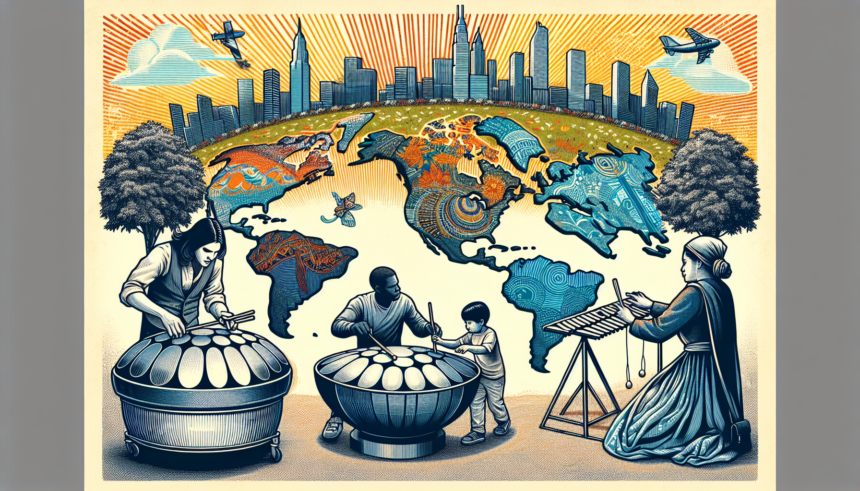The handpan, a relatively young musical instrument, has rapidly gained global popularity over the past two decades. Initially created in the early 2000s, the handpan’s unique, resonant sound and hypnotic qualities have enthralled musicians and listeners alike. Its meteoric rise in popularity spans continents as diverse as Europe, North America, Asia, and beyond. This article delves into the intricacies of the handpan, examines its ascent to worldwide fame, and explores the reasons behind its global appeal.
The Birth and Evolution of the Handpan
The handpan was invented by Felix Rohner and Sabina Schärer of Switzerland’s PanArt company in 2001. Inspired by the traditional steel drum or “steelpan” of Trinidad and Tobago, the handpan was developed as an instrument combining the tuneful qualities of the steelpan with the percussive resonance of a drum. The term “handpan” itself refers to the instrument’s method of play— primarily using one’s hands rather than sticks or mallets.
Over the years, various manufacturers have developed their versions of the handpan, contributing to a diverse range of models available on the market today. The instrument is typically made from steel, semi-spherical, and consists of a central note surrounded by a circle of other notes, enabling players to produce harmonic and melodic sounds simultaneously. Its construction can vary, but the instrument usually consists of two half-shells glued together, with differing note layouts known as “scales.”
Global Spread and Cultural Integration
Since its inception, the handpan has captured the imagination of musicians and enthusiasts worldwide. Europe’s vibrant music scenes in countries like Germany, France, and Italy were early adopters of the instrument. Festivals dedicated solely to the handpan, such as the Hangout UK in England, rapidly emerged, drawing attendees from all over the globe. Additionally, the popularization of social media platforms like YouTube has allowed handpan players to share their compositions and tutorials, fostering an international community of handpan enthusiasts.
In North America, the handpan has found a home in diverse musical genres, from indie and folk music to yoga and meditation circles. The instrument’s soothing sounds and portability make it an attractive choice for personal and communal musical experiences. Renowned handpan players like Daniel Waples and David Kuckhermann have toured extensively across the continent, further spreading the instrument’s fame.
Asia has also embraced the handpan with open arms. In countries like India and Japan, the instrument has been integrated into traditional and contemporary musical practices. The handpan’s versatility allows it to complement a wide range of musical styles, from classical Indian ragas to modern electronic beats. Workshops and events focused on handpan music have become increasingly common, illustrating the instrument’s growing footprint.
Reason for Popularity: Why the Handpan Resonates
The handpan offers a multidimensional appeal that has captivated musicians and listeners of all backgrounds. Here are several reasons why the instrument has garnered international acclaim:
1. Unique Sound Quality
The handpan produces a distinctive sound that is both melodious and percussive. Its ethereal tones, characterized by rich harmonics and sustain, can evoke a wide range of emotions. The instrument’s ability to produce complex, overlapping sounds with a simple hand strike makes it accessible yet profoundly expressive.
2. Accessibility and Playability
Unlike many traditional instruments that require years of practice to achieve proficiency, the handpan is relatively beginner-friendly. Basic melodies and rhythms can be created with ease, encouraging immediate musical exploration. This accessibility has made the instrument popular in educational settings and among amateur musicians.
3. Therapeutic and Meditative Qualities
The handpan’s soothing tones have therapeutic properties, often utilized in music therapy, meditation, and yoga practices. The instrument’s ability to produce calming, resonant sounds aids in relaxation and mindfulness, making it a valuable tool for mental health and wellness.
4. Portability
Weighing around 5 to 9 kg and compact in size, the handpan is remarkably portable. Musicians can easily transport the instrument, making it suitable for outdoor performances, travel, and spontaneous jam sessions. This mobility has contributed significantly to its widespread adoption.
5. Visual Aesthetic
The handpan’s unique appearance, often resembling an alien spaceship or an ancient artifact, adds to its allure. Its metallic sheen and organic form captivate audiences visually, creating a multi-sensory experience that extends beyond sound.
Challenges and Future Prospects
Despite its growing popularity, the handpan faces several challenges. The high demand for quality handpans has led to lengthy waiting lists and elevated prices, making the instrument relatively inaccessible to some potential players. Additionally, the specialized techniques required for manufacturing handpans mean that only skilled artisans can produce high-quality instruments, limiting mass production.
However, these challenges have also fostered creativity and innovation within the handpan community. New materials and production methods are being explored to create more affordable and accessible models. Moreover, the global network of handpan makers and players continues to expand, sharing knowledge and advancing the craft.
Looking to the future, the handpan’s popularity shows no signs of waning. As the instrument continues to be embraced by diverse cultures and musical genres, it is likely to see even greater integration into mainstream music. Collaborations between handpan players and artists from other disciplines, such as dance, visual arts, and film, are also on the rise, promising exciting new forms of artistic expression.
Conclusion
The handpan’s journey from a niche Swiss invention to a globally celebrated instrument is a testament to its unique charm and versatility. Its melodious tones, accessibility, and profound expressive capabilities have endeared it to musicians and listeners across the world. While challenges remain in terms of production and affordability, the handpan’s future looks bright, with continued innovation and cultural integration propelling it forward. As the instrument’s resonance continues to echo across continents, it serves as a harmonious symbol of our shared human connection through music.
Frequently Asked Questions (FAQs)
1. What is a handpan and how is it different from a steel drum?
A handpan is a musical instrument made from steel, played with the hands to produce melodious and percussive sounds. Unlike a traditional steel drum, which originated in Trinidad and Tobago and is played with mallets, the handpan is primarily played using hands and fingers, offering a more nuanced touch and different sound dynamics.
2. How much does a handpan typically cost?
The cost of a handpan can vary widely depending on the manufacturer, scale, and material. Generally, prices range from $1,500 to $3,000. Due to high demand and the artisanal nature of quality handpan production, prices can be quite steep, and there may be waiting lists to purchase one.
3. Can I learn to play the handpan on my own?
Yes, the handpan is known for its accessibility and ease of learning. Many beginners can produce pleasing melodies with little prior musical experience. There are numerous online tutorials, workshops, and community forums available to help newcomers learn the basics and improve their skills.
4. What types of musical genres can the handpan be used in?
The handpan is a versatile instrument suitable for various musical genres. It is commonly used in world music, ambient, folk, indie, meditation, and yoga music. Its ability to blend harmoniously with other instruments makes it an excellent choice for collaborative performances across many genres.
5. Are there different types of handpans?
Yes, there are many different types of handpans, differentiated by their scale, material, and manufacturing technique. Each manufacturer might offer unique scales and designs that produce distinct sounds. Players can choose handpans based on their tonal preferences and musical requirements.





